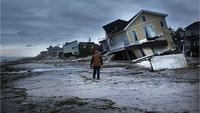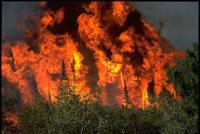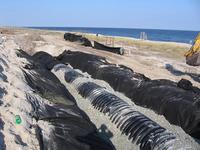-
Americans support preparation for extreme weather, coastal challenges: survey
The challenges posed by rising sea levels and increasingly severe storms will only intensify as more Americans build along the coasts. A just-released NOAA report predicts that already crowded U.S. coastlines will become home to an additional eleven million people by 2020. A Stanford survey finds that the majority of Americans support stronger coastal development codes. Among the most popular policy solutions: stronger building codes for new structures along the coast to minimize damage, and preventing new buildings from being built near the coast.
-
-
U.S. suffered $119 billion in disaster-related losses in 2012

Natural and man-made disasters contributed to $186 billion in economic losses around the world last year. The United States took the biggest hit with $119 billion in losses. Insurance claims for weather-related losses in 2012 totaled $77 billion dollars, the third most expensive losses on record. Nine of the top ten most expensive insured loss events which occurred last year happened in the United States.
-
-
Suppressing naturally occurring blazes increases wildfire risk

According to the National Interagency Fire Center, 9.3 million U.S. acres burned in wildfires in 2012 compared with 3.57 million acres affected in 2001 and 2.95 million in 1991. One reason for the increase in the number of acres consumed by wildfires is the U.S. government’s policy of suppressing of naturally occurring blazes. Researchers say that this policy can have unintended consequences, including making wildfires more severe.
-
-
How U.K. can better prepare for emergencies
Well designed and planned exercises are essential to ensure that the United Kingdom can respond effectively to emergencies of all kinds. The emergencies may take the form of a terrorist attack, flooding, pandemic flu, rail or air disaster — or any major disruptive event requiring an emergency response.
-
-
NOAA predicts drought, flooding, warm weather for spring
The U.S. National Oceanic and Atmospheric Agency (NOAA) yesterday issued the three-month U.S. Spring Outlook, saying Americans should brace themselves for the following: above-average temperatures across much of the continental United States, including drought-stricken areas of Texas, the Southwest, and the Great Plains. These areas, and Florida, will see little drought relief owing to below- average spring precipitation. River flooding is likely to be worse than last year across the country.
-
-
Flood insurance program needs better approach to analyzing flood risk
In administering the National Flood Insurance Program, the Federal Emergency Management Agency (FEMA) needs a more modern approach to analyzing and managing flood risk behind levees — one that would give public officials and individual property owners a clearer idea of the risks they face and how they should address them. Because levees can reduce but not eliminate the risk of flooding, the agency should also encourage communities behind levees to use multiple methods to reduce risk and increase awareness of these risks.
-
-
Improved weather, climate predictions strengthen the U.S. economy
The economic costs of damaging weather events have an immense and increasing impact on the U.S. economy. These costs could be anticipated and mitigated by improved weather and climate predictions, say a range of experts in the public and private sectors. These experts will meet in early April in an American Meteorological Society event to discuss the economic benefits of how environmental forecast, prediction, and observation programs and services strengthen the U.S. economy.
-
-
Hidden dune filters treat coastal stormwater runoff

When it rains, untreated stormwater can sweep pollutants into coastal waters, potentially endangering public health. Now researchers have developed low-cost filtration systems that are concealed beneath sand dunes and filter out most of the bacteria that can lead to beach closures.
-
-
Does warmer climate mean stormier, or only wetter, weather?
Many scientists argue that the climate has warmed since people began to release massive amounts greenhouse gases to the atmosphere during the Industrial Revolution. These scientists, however, are less sure that warming climate creates stormier weather. The reason: nobody has done the quantitative analysis needed to show this is indeed happening. Until now.
-
-
Helping coal miners escape underground disasters
Recent advances in mining research and practices have improved the safety and health of underground coal miners and extensive rescue strategies are in place, but more coordinated planning and training are needed better to prepare miners to escape in the event of a mine emergency, says a new report from the National Research Council.
-
-
2012 economic losses from disasters set new record at $138 billion
The UN Office for Disaster Risk Reduction (UNISDR) reported that for the first time in history, the world has experienced three consecutive years in which annual economic losses have exceeded $100 billion. The losses are the result of an enormous increase in exposure of industrial assets and private property to extreme disaster events.
-
-
New structure for regulation of geoengineering research needed: experts
Geoengineering, the use of human technologies to alter the Earth’s climate system — such as injecting reflective particles into the upper atmosphere to scatter incoming sunlight back to space — has emerged as a potentially promising way to mitigate the impacts of climate change. Such efforts, however, could present unforeseen new risks. This inherent tension has thwarted both scientific advances and the development of an international framework for regulating and guiding geoengineering research.
-
-
Predicting landslides

A landslide can seriously injure or even kill people. Now, a new early warning system will be the first to employ geological data in tandem with the latest weather forecasts to provide a concrete warning in emergency situations.
-
-
Urgent need to find asteroids that threaten Earth: expert
The impact from a 100-meter long asteroid hitting Earth would be equal to detonating a 100-megaton hydrogen bomb. Several large asteroids have zipped dangerously close to Earth in the past month. There are millions of these near-Earth-orbit (NEOs) asteroids longer than 100 meters. Because they are relatively small, and because they spend so much time far from Earth, scientists tend to find them only by chance.
-
-
Russia embarking on a program to thwart asteroid threat
Officials from Rosatom, Russia’s nuclear agency, and from Russia’s space agency, yesterday (Tuesday) told a special conference at the Russian Federation Council, the Russian upper house, that Russia was embarking on an ambitious program – estimated to cost about $2 billion – to shield Russia from the threat of asteroids and meteors. The first steps will be taken by the end of the year, but the comprehensive set of measures will not be available until 2018-20. The officials discussed various possible measures, ranging from planting beacon transmitters on asteroids to megaton-sized nuclear strikes to destroy asteroid or divert them from a course which would lead to a collision with the Earth.
-
More headlines
The long view
Using Drone Swarms to Fight Forest Fires
Forest fires are becoming increasingly catastrophic across the world, accelerated by climate change. Researchers are using multiple swarms of drones to tackle natural disasters like forest fires.
How Climate Change Will Affect Conflict and U.S. Military Operations
“People talk about climate change as a threat multiplier,” said Karen Sudkamp, an associate director of the Infrastructure, Immigration, and Security Operations Program within the RAND Homeland Security Research Division. “But at what point do we need to start talking about the threat multiplier actually becoming a significant threat all its own?”
